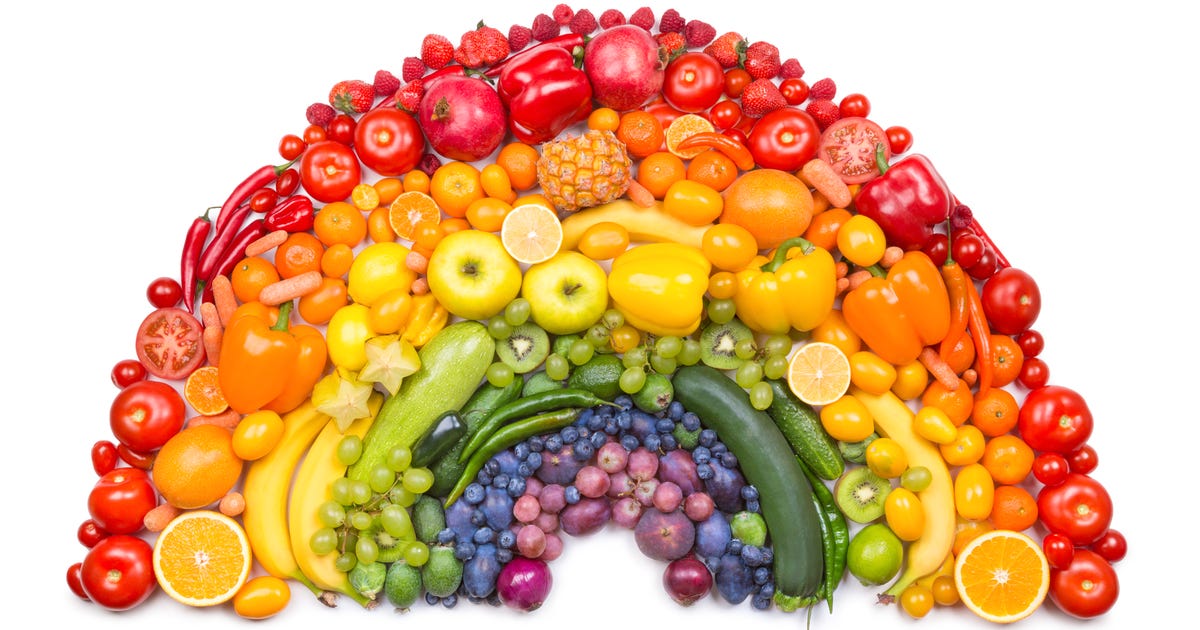
Building an eating pattern that’s both nutritious and easy enough to follow day in and day out is easier said than done. While headlines about the latest “superfood” or a new promising diet pass by like billboards on the highway, we’re often left to sort through a barrage of wellness advice to find something that’s actually healthy and applicable to everyday life.
Finding simple ways to improve the overall nutrition of your diet, without restricting food groups or resigning yourself to the obsessiveness of calorie-counting, is a more sustainable approach to nutrition for most people. One way to start is to eat for color, or what some call “eating the rainbow” in order to fill your plate(s) and add more macro- and micronutrients to your diet. And it works exactly how it sounds: eating foods that come in a variety of colors.
Benefits of eating the rainbow
They’re not the only colors you should be eating (there are “blander” colors that provide protein and fiber, for example), but spicing up your plate with a couple bright pops of color a la fruits and veggies is a great way to achieve diet diversity – that is, ensuring you’re getting a sufficient rotation of the many different vitamins and minerals.
The exact number of fruit and vegetable servings someone needs may be hard to quantify, and can vary based on their individual body or other factors, but one study found that two servings of fruit and three servings of vegetables daily decreased the risk of mortality in adults. But the goal of eating for color isn’t to count servings – it’s to increase the range of foods and nutrients you consume so you can keep a sustainable goal.
Phytonutrients contribute to the color of plant-based foods. Phytonutrients not only protect the plant itself from disease or excessive sun, but humans eating them may be able to reap tons of health benefits, including anti-cancer and anti-heart disease effects, explains Katherine McManus, director of the Department of Nutrition and director of the Dietetic Internship at the Brigham and Women’s Hospital, in a post for Harvard Health Publishing.

Adding a new fruit or veggie to your weekly diet is an easy way to increase the variety of phytonutrients your body gets.
Luis Alvarez/Getty Images
What’s in each color of food?
Despite “ample evidence” supporting a diet rich not only in colorful fruits and vegetables, but also legumes, whole grains and nuts, evidence fully linking a specific health benefit to a phytochemical is limited due to the fact that these plant foods are abundant in various compounds that are beneficial to health, according to Oregon State University’s Micronutrient Information Center.
Still, there are some known health benefits linked to each produce or color group. And as a general rule, darker-colored foods have a higher phytonutrient content. According to information Oregon State University, Stanford Medicine and McManus’ Harvard Health post, here’s an outline of some color-based benefits:
Red plants contain carotenoids such as lycopene that may protect against heart and lung disease and certain types of cancers such as prostate. (For example: tomatoes, apples, beets, strawberries.)
Purple and blue produce contain anthocyanins, which may help slow aging in our bodies, prevent blood clots, protect against heart disease, fight inflammation and allergies. (For example: plums, prunes, eggplant, blueberries, blackberries.)
Yellow and orange fruits and veggies contain carotenoids such as cryptoxanthin that may promote vision function, reduce the risk of cardiovascular disease and more. (For example: carrots, orange, cantaloupe, sweet potatoes.)
Green plants contain sulforaphane, isocyanate and indoles that may destroy cancer-causing chemicals. (For example: broccoli, bok choy, kale, Brussels sprouts.)
White and brown, flavorful favorites, specifically onion and garlic, contain allicin, which may block certain toxins or bacteria.
Don’t neglect the beige foods: The importance of rice and other grains
To effectively eat for color, your daily roundup of plates and snacks shouldn’t look like a spilled sleeve of Skittles. Your diet should also include grains, or the less “colorful” colors like white, brown or tan foods. These include whole grains, which naturally contain fiber, B vitamins and minerals such as magnesium.
Another note when eating for color: Don’t neglect protein, which you can find in both plant-based foods (beans, legumes, nuts, tofu) and animal products. Protein helps us build and maintain strength, regulate hormones and more.
How to fill your plate with color
In addition to the specific nutritional benefits that come with each food and each color, the main point of “eating for color” or tasting the rainbow is to build a healthy and sustainable relationship with food and diet that won’t burn you out – and will keep you up to date on the revolving door of superfoods, whatever they may be. For starters, you could use your next trip to the grocery store as an excuse to try a new color, or a new food group, and experiment with different foods within the same “color” group. You can also add more herbal teas and spices, which also contain phytonutrients.
It’s your diet – have some fun with it.
The information contained in this article is for educational and informational purposes only and is not intended as health or medical advice. Always consult a physician or other qualified health provider regarding any questions you may have about a medical condition or health objectives.
